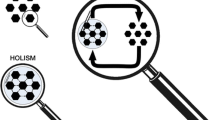Abstract
The issue as to whether computer simulation can be considered a valid tool for improving the predictive capacity of social scientific theories is still controversial (e.g., Troitzsch 1997 and Scott et al. 1997, seem to deny it). Instead, the role of computer simulation for testing models and experimenting on social phenomena is denied by no-one in the field (see Halpin 1997).
Preview
Unable to display preview. Download preview PDF.
Similar content being viewed by others
References
Chattoe, E., Gilbert, N.: A simulation of budgetary decision-making based on interview data. In: Paper presented at SimSoc 1995, University of Florida, Boca Raton, September 15-17 (1995) (in press); Journal of Artificial Societies and Social Simulation (to appear)
Conte, R., Castelfranchi, C.: Simulating interdependence networks. A two-way approach to the micro-macro link. In: Troitzsch, K.G., Mueller, U., Gilbert, N., Doran, J. (eds.) Social Sience Microsimulation. Springer, Heidelberg (1996)
Conte, R., Paolucci, M.: Tributes or norms? The context-dependent rationality of social control. In: Conte, R., Hegselmann, R., Terna, P. (eds.) Simulating social phenomena. Springer, Heidelberg (1997)
Conte, R., Sichman, J.: DEPNET: How to benefit from social dependence. Journal of Mathematical Sociology 20(2-3), 161–177 (1995)
Conte, R. (1997). Diversity in strategies of partnership formation. Paper presented at the Dagstuhl Seminar on Social Science Microsimulation. Tools for Modeling, Parameter Optimization, and Sensitivity Analysis, Schloss Dagstuhl, May 1-5 (1997)
Elster, J.: Sour grapes. Studies in the sub-version of rationality. Cambridge University Press, Cambridge (1985)
Gmytrasiewicz, P.J.: On Reasoning About Other Agents. In: DIMAS1995 - Proceedings of the First International Workshop on Decentralized Intelligent and Multiagent Systems, Krakov, Poland, November 22, pp.I/38-49 (1995)
Halpin, B. (1997). Simulation in Sociology: A review of the literature. In: Paper read at the Workshop on Potential of the computer simulation for the social sciences, Centre for Research in the Social Sciences (CRESS), University of Surrey, January 14-15 (1998)
Hargreaves-Heap, S.: Post-modernity and new conceptions of rationality in economics. In: Gerrard, B. (ed.) The economics of rationality. Routledge, London (1993)
Harsanyi, J.C.: Advances in understanding rational behavior. In: Moser, P.K. (ed.) Rationality in action. Contemporary approaches. Cambridge University Press, Cambridge (1990)
Krause, U.: On the resolution of conflict by compensation. In: Nell, E.J., Semmle, W. (eds.) Nicholas Kaldor and mainstream economics. Macmillan, London (1991)
Miller, G., Galanter, E., Pribram, K.H.: Plans and the structure of behavior. Holt, Rinehart & Winston, New York (1960)
Moser, P.K.: Rationality in action: general introduction. In: Moser, P.K. (ed.) Rationality in action. Contemporary approaches. Cambridge University Press, Cambridge (1990)
Moss, S., Edmonds, B., Wallis, S.: Validation and Verification of Computational Models with Multiple Cognitive Agents, CPM Report No.: 97-25 (1997)
Sichman, J.S., Conte, R., Castelfranchi, C., Demazeau, Y.: A social reasoning mechanism based on dependence networks. In: Cohn, A.G. (ed.) Proceedings of the 11th. European Conference on Artificial Intelligence, pp. 188–192. John Wiley & Sons, Baffins Lane (1994)
Simon, H.A.: Cognitive architectures and rational analysis: Comment. In: VanLehn, K. (ed.) Architectures for intelligence. Lawrence Erlbaum, Hillsdale (1991)
Steedman, I., Krause, U.: Goethe’s Faust, Arrow’s Possibility Theorem and the individual decision-taker. In: Elster, J. (ed.) The multiple self. Cambridge University Press. Elster, Cambridge (1986)
Troitzsch, K.G.: Social science simulation - Origin, prospects, purposes. In: Conte, R., Hegselmann, R., Terna, P. (eds.) Simulating social phenomena. Springer, Heidelberg (1997)
Veneziano, V., Conte, R., Castelfranchi, C.: MICROdep The formation of partnerships. In: Paper presented at the Workshop on Multi-Agent Systems and Social Simulation (MASSIM 1996). University of Ulm, Germany (1996)
Author information
Authors and Affiliations
Editor information
Editors and Affiliations
Rights and permissions
Copyright information
© 1998 Springer-Verlag Berlin Heidelberg
About this paper
Cite this paper
Conte, R., Pedone, R. (1998). Finding the Best Partner: The PART-NET System. In: Sichman, J.S., Conte, R., Gilbert, N. (eds) Multi-Agent Systems and Agent-Based Simulation. MABS 1998. Lecture Notes in Computer Science(), vol 1534. Springer, Berlin, Heidelberg. https://doi.org/10.1007/10692956_11
Download citation
DOI: https://doi.org/10.1007/10692956_11
Publisher Name: Springer, Berlin, Heidelberg
Print ISBN: 978-3-540-65476-6
Online ISBN: 978-3-540-49246-7
eBook Packages: Springer Book Archive




